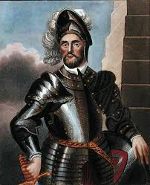King John Balliol of Scotland
John Balliol was King of Scotland for a short period of time at the end of the 13th Century, amid a turbulent time in England and Scottish history. Caught in a power vacuum, he never really got a chance to exercise his authority as king. Balliol was born in 1248 to John, Baron Balliol and Devorguilla of Galloway, who was a descendent of a previous king, King David I. King Alexander III had died in 1286 without an heir. He had thought to have his 4-year-old granddaughter succeed him in some sort of regency arrangement, but she was in Norway when her grandfather died and, when Scotland was finally ready to receive her, she died on the way there.Filling the remaining power vacuum was England's King Edward I, who appointed himself the head of a 105-member committee who considered the claims of 13 nobles and then selected Balliol as king.
Balliol had put forward a claim based on his descendancy of David of Huntingdon, a brother of a previous Scottish king, William the Lion. He was crowned king in Scone on November 17, 1292. Balliol was King of Scotland in name but not in fact. He paid homage to Edward personally and was seen as a glorified vassal by other Scottish nobles, many of whom had opposed him during the Great Cause. Robert Bruce refused to recognize Balliol as king. The nobles regarded him as weak and ineffective. Fed up with Balliol's ineffectiveness, the Scottish nobles made their own alliance with Philip, the king of France, in 1295 and attacked the border town of Carlisle. England's King Edward I, fearing an invasion from both France and Scotland, determined to put an end to the alliance and invaded Scotland in 1296, sacking Berwick along the way. Edward declared Balliol's kingship null and void, and Balliol abdicated on July 10. In the process, the arms of Scotland were formally torn from his surcoat, leading to his denigrating nickname of Toom Tabbard, meaning "Empty Coat." Edward, not satisfied with a mere abdication, had him imprisoned in the Tower of London. Edward became the nominal ruler of Scotland and reinforced his authority by taking the Stone of Destiny–on which all Scottish kings had been crowned since time immemorial–and installing it in Westminster Abbey. Edward agreed to free Balliol in 1299. He left England and Scotland for good, retiring to Normandy, where he died in 1314. Balliol married Isabella de Warenne in 1281. They had a son, Edward, who later claimed the Scottish throne. See also Early Medieval Scottish rulers. |
|
Social Studies for Kids
copyright 2002–2026
David White




